

Lenovo Premium Notebook: Can it do more than look pretty?
The Yoga S940-14IWL is a 14" premium notebook. It has a bright UHD display, 16 GB RAM and a 512 GB SSD. Nevertheless, it can't do much more than Office.
The Yoga range was once known for devices that were particularly flexible to use. But that is a thing of the past. This notebook is not a convertible. Nor does it have an integrated graphics tablet, as the Android Yoga Book once did. Today, Lenovo uses the Yoga designation for devices that are intended to cover the premium segment. And this is not only noticeable in the materials selected and the workmanship - it is also reflected in the price.

Technical data:
- Intel Core i7-8565U
- Integrated graphics processor: Intel UHD Graphics 620
- 16 GB RAM (LPDDR3-2132, 2 x 8 GB SanMax K4EBE304EC-EGCG)
- 512 GB SSD (M.2, PCIe 3.0 x4 / NVMe 1.2a, Samsung MZVLB512HAJQ-000L2)
- 14" IPS display with 3840 x 2160 pixels (high-gloss, 500 cd/m², HDR VESA400)
- Four speakers with Dolby Atmos certification, microphone, 3.5 mm headphone/microphone combo jack
- 720p front camera
- IR camera for facial recognition
- 4-cell lithium polymer battery with 52 Wh
- Windows 10 Home
Simple design that doesn't pass the drop test
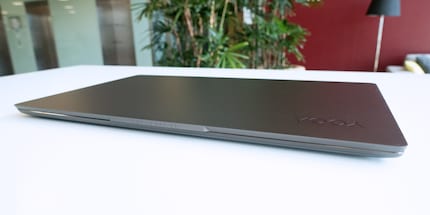
The Yoga notebook comes in a compact case made of iron-grey, sandblasted aluminium. Unfortunately, I dropped it within the first few minutes - not directly onto the carpet in the office, but with the underside on the power supply unit. The drop height of around 90 cm is enough to give the case a small memory dent.
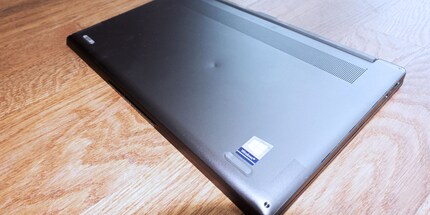
Dent on the underside or not, the simple design of the notebook is pleasing. It is 31.93 cm wide, 19.74 cm deep and measures 1.22 cm at its thinnest point at the front. If I measure the area behind the keyboard, it is 1.4 cm thin.
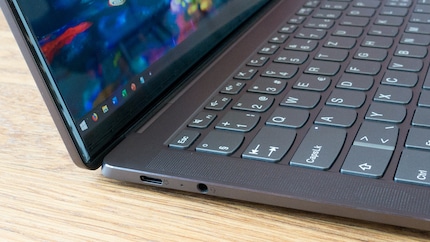
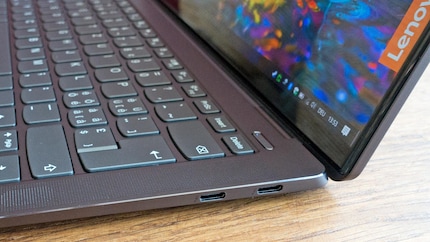
As far as the connections are concerned, you get a USB-C 3.1 port on the left-hand side, which also serves as a DC input. You can use it to charge the notebook and connect peripherals. Next to it is a combined jack connection for microphone and headphones. Two Thunderbolt ports (USB-C) are installed on the right-hand side.
Good display by notebook standards
Not so long ago, I would have been keen to point out that this notebook offers a 14-inch display in a 13-inch chassis. However, small dimensions and minimal screen bezels are now commonplace.
I measure 7 mm at the top, 9 mm at the bottom and 4 mm at each side of the display. Incidentally, it is slightly curved at the sides, as you would expect from smartphones. But the curvature is already outside the display area.
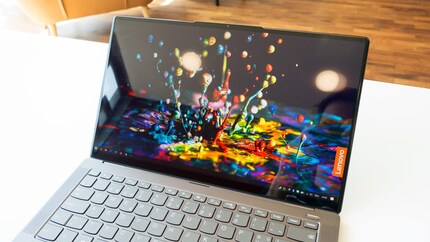
In terms of technology, you get an HDR VESA400-certified IPS UHD display. The resolution is therefore 3840 x 2160 pixels. It is a high-gloss display, which can be extremely annoying due to the reflections depending on the work situation, or a little more pleasing with a few light sources. But mostly it is annoying. According to the manufacturer, it comes with good backlighting, which should provide 500 cd/m² luminosity at the brightest level.
I check whether the brightness is correct using a colour calibration system, the x-rite i1Display Pro.
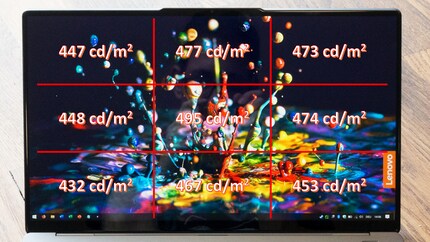
With an average of 463 cd/m², the brightness is below the specified value, but it is still very good for a notebook display. This means you can also work in sunlight. Or you could - if it didn't have that high-gloss gimmick that only Apple fanatics usually like. As you can see in the picture above, the illumination of the panel is unfortunately not quite even - there is a lack of brightness on the left-hand side. However, I don't notice this when watching films or working.
I also measure the colour space coverage and contrast. I measured a good value of 99.4 per cent for the sRGB colour space. I also measured 76.5 per cent for Adobe RGB and 89.9 per cent for DCI P3. A display suitable for graphic designers should cover at least 90 per cent of Adobe RGB. This is not achieved here. But no matter, without a dedicated graphics card, Photoshop and co. are only half as much fun when editing large RAW images anyway.
The panel achieves a static contrast value of 1202:1, while the dynamic contrast is 5716:1.
A pleasantly springy keyboard
The chicklet-style keyboard has a low key travel of 1.3 mm. It is very comfortable to type on after a short period of familiarisation - it is pleasantly springy, has a clear actuation point and is very quiet. In contrast to other clattery keyboards (see MacBook Air), this one is also suitable for open-plan offices thanks to its good damping.
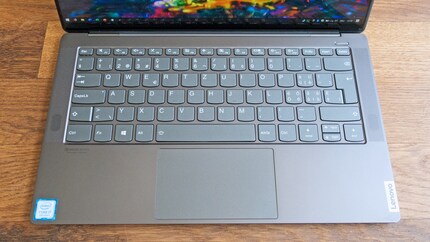
The touchpad is somewhat small at 10.5 x 6.3 cm due to the limited space. Nevertheless, the mouse can be operated with pinpoint accuracy, not least thanks to the Precision driver. The pointer moves quickly and after a short time I get used to the slightly smaller dimensions.
Great notebook speakers
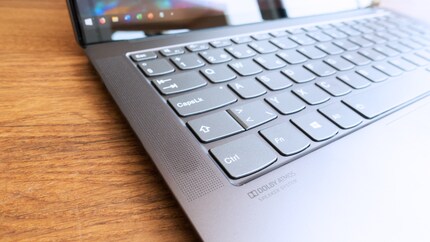
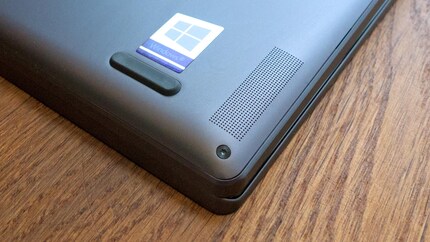
The notebook has a total of four speakers with Dolby Atmos certification. Two of them are located next to the keyboard and two below the chassis in the front corners. Apart from the usual lack of bass in notebooks, the sound is really good. The mids and highs are crystal clear and the breadth of the sound impresses me. This is particularly enjoyable when watching films in combination with the good, HDR VESA400-capable screen.
Weak battery performance during continuous YouTube streaming
When streaming YouTube continuously, I set the brightness of the display to the medium level. The automatic shutdown occurs after 4 hours and 55 minutes. This is pretty much the worst result I have ever measured with a notebook. The best in this discipline so far was a HP Spectre x360 with 8 hours and 47 minutes.
Even when working in the office, the battery doesn't last as long as I would like. After six and a half to seven hours, it comes to an end.
Battery performance: stress test with HeavyLoad and Furmark
To push all the hardware to its limits, I ran the HeavyLoad stress test and FurMark at the same time with the screen at maximum brightness. The battery dies after 1 hour and 53 minutes, which is a pretty good performance. However, this result is only achieved due to the lack of a dedicated graphics card.
CPU and graphics processor
The 64-bit quad-core Intel Core i7-8565U SOC was introduced in Q3 2018. As an economical processor, it is intended for notebooks and ultrabooks. It is based on the Whiskey Lake microarchitecture and is manufactured using the 14nm++ process. The base clock is 1.8 GHz, the turbo clock is 4.6 GHz with a single core - 4.1 GHz when all cores are used. The specified power consumption is 15 watts. However, the TDP can be between 7.5 and 25 watts depending on the intended use and manufacturer.
The chip is also equipped with Intel's UHD Graphics 620, which runs at 300 MHz and has a maximum dynamic frequency of 1.15 GHz.
Performance: Cinebench R15 and R20
With Cinebench from Maxon, you can test how your PC or processor performs when rendering Cinema 4D content. A new version of the popular benchmark has just been released. For better comparability with our previous reviews, I have run the old and new versions.
This is how the Yoga performs with Cinebench R15:
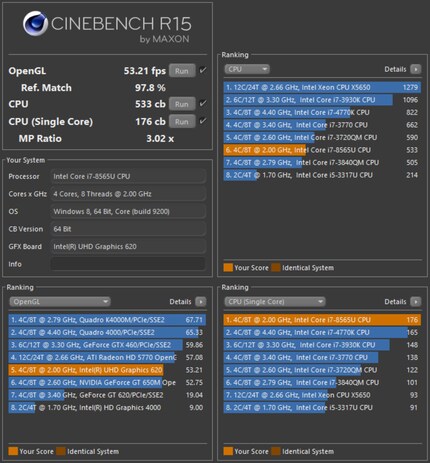
The 533 points achieved in the multi-core benchmark are a good result for an office laptop. This puts the Yoga roughly on a par with the Acer TravelMate X3 (543 points), the Asus ZenBook 14 (569 points) and the Lenovo ThinkPad E580 (558 points).
.
As far as the graphical performance is concerned, you can't expect much due to the lack of a dedicated graphics card. The 53.21 fps achieved are most comparable to the tested Microsoft Surface Pro 6 (52.11 fps), which also runs with the UHD Graphics 620.
This is how the Yoga performs with Cinebench R20:
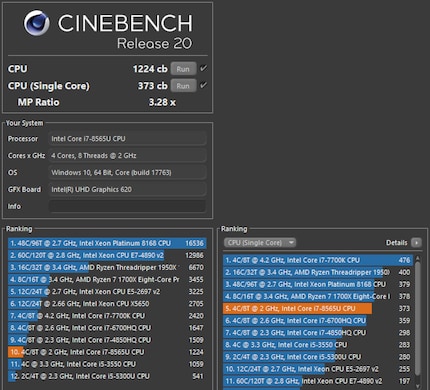
Performance: Geekbench 4
Geekbench 4 is a cross-platform benchmark. It runs on Windows, MacOS, Linux, Android and iOS. In version 4 of the CPU benchmark, the base value of 4000 points reflects the performance of an Intel Core i7-6600U clocked at 2.60 GHz. In addition to simulated real-world scenarios with which the CPU is tested (single-core and multi-core), Geekbench can also determine GPU performance in the areas of image processing and machine vision. You can also compare the results with other systems thanks to the Geekbench browser.
Geekbench results of the Yoga:
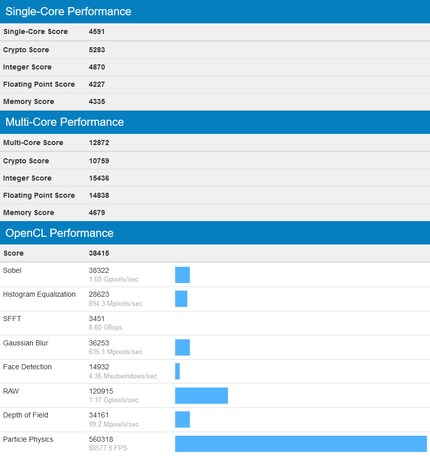
These Geekbench 4 results are most comparable to the Microsoft Surface Laptop 2. However, the Yoga performs better in the single-core benchmark. In the multi-core and OpenCL benchmark, the devices are almost on a par - but the Yoga still performs a tad better there too.
If you want to see the benchmark results in detail:
Performance: PCMark 10
Thanks to PCMark 10 from 3DMark, PCs and notebooks can be tested for a wide range of tasks at a workstation - except for getting coffee. It is an office benchmark and is suitable for all devices for which a gaming benchmark makes no sense due to weak hardware.
The Yoga scores 3374 points in this benchmark. If you look at the result on the 3DMark homepage, you can see that this device is better than an average office PC, but not good enough to be considered a weak gaming PC.
Conclusion: Nice design, good components, but...
Really good what Lenovo has put into this device. The screen, keyboard and speakers are better than on many other notebooks. It responds quickly and is appealing due to its compact size and simple design. Nevertheless, I am disappointed by it all. And that's not even due to the meagre battery performance.
The Lenovo Yoga S940-14IWL can't be used for much more than office and media consumption due to its lack of graphics power. Even though watching films on the go is a pleasure, I wonder how often I would use it for that. Probably too little to justify the price. I also wonder whether I really need 16 GB RAM, a 512 GB SSD and a reflective UHD display for Netflix and office work.
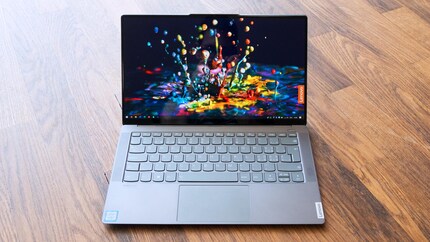
For a notebook that costs over 2100 francs without a promotional price (as of 26 June 2019), it should have a weak dedicated graphics card. Or at least it shouldn't dent in the first few minutes of a fall from a low height. However, this is something that is difficult to avoid with a thin aluminium chassis. Nevertheless, at the given price, before I buy the Yoga, I would at least insist on an extra in the form of a gold-plated frame or a free stand to annoy Apple users.
In my opinion, a 14-inch notebook for office work and film consumption should only cost half as much - if at all. Great design or not. After all, if you go shopping in your car, you don't need an A.I.T.T.
What should be included in a 2100 franc notebook?
- An entry-level graphics card for Photoshop15%
- A midrange graphics card (or better) for gaming43%
- A free stand to annoy Apple customers as well as the company Apple Inc.42%
The competition has ended.
Follow me if you would like to take part in other great surveys.
I find my muse in everything. When I don’t, I draw inspiration from daydreaming. After all, if you dream, you don’t sleep through life.


